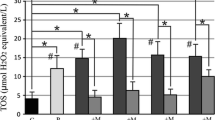We performed comparative analysis of 8-hydroxy-2’-deoxyguanosine in women in different climax stages with and without insomnia. The study involved 90 women aged 45 to 60 years divided into perimenopausal (n=30) and postmenopausal (n=60) groups. After questioning using special sleep questionnaires (Insomnia Severity Index, Epworth Sleepiness Scale, Munich Chronotype Questionnaire), the groups were divided into subgroups with insomnia and without it (control). 8-Hydroxy-2’-deoxyguanosine was assayed in blood serum by ELISA. The higher levels of 8-hydroxy-2’-deoxyguanosine in postmenopausal women with insomnia in comparison with the control and perimenopausal patients (p<0.05) attested to oxidative DNA damage in this cohort of patients.
Similar content being viewed by others
References
Kolesnikova LI, Darenskaya MA, Kolesnikov SI. Free radical oxidation: a pathophysiologist’s view. Byull. Sib. Med. 2017;16(4):16-29. Russian.
Poluektov MG, Buzunov RV, Averbukh VM, Verbitskiy EV, Zakharov AV, Kel’manson IA, Korabel’nikova EA, Litvin AYu, Madaeva IM, Pal’man AD, Rusetskiy YuYu, Strygin KN, Yakupov EZ. Project of clinical recommendations on diagnosis and treatment of chronic insomnia in adults. Nevrologiya Revmatologiya. Pril. Zh. Consilium Medicum. 2016;(2):41-51. Russian.
Semenova NV, Madaeva IM, Kolesnikova LI. The role of melatonin as a component of the antioxidant defense system in perimenopausal women with insomnia. Zh. Nevrol. Psikhiatr. 2019;119(7):7-13. Russian.
Sukhikh GT, Smetnik VP, Yureneva SV, Ermakova EI, Chernykha GE, Yakushevskaya OV. Menopause and Climacteric Conditions in Women. Clinical Guidelines. Moscow, 2016. Russian.
Cobley JN, Fiorello ML, Bailey DM. 13 reasons why the brain is susceptible to oxidative stress. Redox Biol. 2018;15:490-503. doi: https://doi.org/10.1016/j.redox.2018.01.008
Gulec M, Ozkol H, Selvi Y, Tuluce Y, Aydin A, Besiroglu L, Ozdemir P.G. Oxidative stress in patients with primary insomnia. Prog. Neuropsychopharmacol. Biol. Psychiatry. 2012;37(2):247-251. doi: https://doi.org/10.1016/j.pnpbp.2012.02.011
Hachul de Campos H, Brandão LC, D’Almeida V, Grego BH, Bittencourt LR, Tufik S, Baracat EC. Sleep disturbances, oxidative stress and cardiovascular risk parameters in postmenopausal women complaining of insomnia. Climacteric. 2006;9(4):312-319. doi: https://doi.org/10.1080/13697130600871947
Kolesnikova LI, Madaeva IM, Semenova NV, Suturina LV, Berdina ON, Sholohov LF, Solodova EI. Pathogenic role of melatonin in sleep disorders in menopausal women. Bull. Exp. Biol. Med. 2013;156(1):104-106. doi: https://doi.org/10.1007/s10517-013-2289-8
Luo J, Mills K, le Cessie S, Noordam R, van Heemst D. Ageing, age-related diseases and oxidative stress: What to do next? Ageing Res. Rev. 2020;57:100982. doi: https://doi.org/10.1016/j.arr.2019.100982
Semenova NV, Madaeva IM, Kolesnikov SI, Solodova EI, Kolesnikova LI. Insomnia in Peri- and Postmenopausal Women: Plasma Lipids, Lipid Peroxidation and Some Antioxidant System Parameters. Neuropsychiatry (London). 2018;8(4):1452-1460. doi: https://doi.org/10.4172/Neuropsychiatry.1000477
Trivedi MS, Holger D, Bui AT, Craddock TJA, Tartar JL. Short-term sleep deprivation leads to decreased systemic redox metabolites and altered epigenetic status. PLoS One. 2017;12(7):e0181978. doi: https://doi.org/10.1371/journal.pone.0181978
Qing X, Shi D, Lv X, Wang B, Chen S, Shao Z. Prognostic significance of 8-hydroxy-2’-deoxyguanosine in solid tumors: a meta-analysis. BMC Cancer. 2019;19(1):997. doi: https://doi.org/10.1186/s12885-019-6189-9
Urbaniak SK, Boguszewska K, Szewczuk M, Kaźmierczak-Barańska J, Karwowski BT. 8-Oxo-7,8-Dihydro-2’-Deoxyguanosine (8-oxodG) and 8-Hydroxy-2’-Deoxyguanosine (8-OHdG) as a Potential Biomarker for Gestational Diabetes Mellitus (GDM) Development. Molecules. 2020;25(1):202. doi: https://doi.org/10.3390/molecules25010202
Zavada A, Gordijn MC, Beersma DG, Daan S, Roenneberg T. Comparison of the Munich Chronotype Questionnaire with the Horne-Ostberg’s Morningness-Eveningness Score. Chronobiol. Int. 2005;22(2):267-278. doi: https://doi.org/10.1081/cbi-200053536
Zhi SM, Fang GX, Xie XM, Liu LH, Yan J, Liu DB, Yu HY. Melatonin reduces OGD/R-induced neuron injury by regulating redox/inflammation/apoptosis signaling. Eur. Rev. Med. Pharmacol. Sci. 2020;24(3):1524-1536. doi: https://doi.org/10.26355/eurrev_202002_20211
Author information
Authors and Affiliations
Corresponding author
Additional information
Translated from Byulleten’ Eksperimental’noi Biologii i Meditsiny, Vol. 171, No. 3, pp. 369-372, March, 2021
Rights and permissions
About this article
Cite this article
Semenova, N.V., Madaeva, I.M., Brichagina, A.S. et al. 8-Hydroxy-2’-Deoxyguanosine as an Oxidative Stress Marker in Insomnia. Bull Exp Biol Med 171, 384–387 (2021). https://doi.org/10.1007/s10517-021-05233-0
Received:
Published:
Issue Date:
DOI: https://doi.org/10.1007/s10517-021-05233-0




